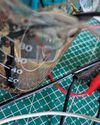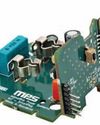AUTOMATIC WIPER CONTROL For Three/Four Wheelers
October 2024
|Electronics For You
The integration of a 555 timer and L293D motor driver in an automatic wiper control device presents a practical and efficient solution for enhancing driver safety and convenience.

This system, with its simplicity and cost-effectiveness, can be a valuable addition to both three- and fourwheelers. Fig. 1 shows the author’s prototype on a breadboard.
Circuit and working
The circuit diagram of the automatic wiper control for three/four-wheelers is shown in Fig. 2. It is built around a 12V battery, timer 555 (IC1), motor driver L293D (IC2), 5V voltage regulator 7805 (IC3), and a few other components. LED1 acts as a power-on indicator when switch S1 is turned on, activating the wiper control system.
 The heart of the device is the 555 and L293D. The 555 timer (IC1) is a highly stable integrated circuit used for generating precise time delays or oscillation. It is wired as an astable multivibrator. In a traditional astable multivibrator circuit, a duty cycle of 50% or less cannot be generated. To achieve a duty cycle of less than 50%, diode D1 is added across resistor R3, resulting in an output frequency of approximately 0.03Hz. The output of IC1 is given to transistors T1 and T2 to provide pulses, which are used as the inputs of IC2 to drive the L293D.
The heart of the device is the 555 and L293D. The 555 timer (IC1) is a highly stable integrated circuit used for generating precise time delays or oscillation. It is wired as an astable multivibrator. In a traditional astable multivibrator circuit, a duty cycle of 50% or less cannot be generated. To achieve a duty cycle of less than 50%, diode D1 is added across resistor R3, resulting in an output frequency of approximately 0.03Hz. The output of IC1 is given to transistors T1 and T2 to provide pulses, which are used as the inputs of IC2 to drive the L293D. هذه القصة من طبعة October 2024 من Electronics For You.
اشترك في Magzter GOLD للوصول إلى آلاف القصص المتميزة المنسقة، وأكثر من 9000 مجلة وصحيفة.
هل أنت مشترك بالفعل؟ تسجيل الدخول
المزيد من القصص من Electronics For You

Electronics For You
Tech Majors Are Racing TOWARDS NET-ZERO - What About You?
Apple, Microsoft, Amazon, Google, Infosys, Wipro—global and Indian firms are heading closer to achieving net-zero emissions, a mandate to combat climate change. Here is what you need to know to start your journey...
12 mins
December 2025

Electronics For You
Miniature IoT WATER TDS And LEVEL MONITOR Cum CONTROLLER
For setups that rely on stored water, clear awareness of tank level and water quality is essential.
3 mins
December 2025

Electronics For You
The Impact Of GENERATIVE AI On The Future Of AUTOMOTIVE AND EVs
Autonomous vehicles, connected ecosystems, and smart factories are only the beginning. Generative Al is pushing the auto industry beyond predictions into a bold era of creativity-from EV design to real-time diagnostics and showroom automation. Here is how GenAl is reshaping innovation across the automotive value chain.
8 mins
December 2025

Electronics For You
How AI Tools Are Making SOFTWARE DEVELOPMENT BETTER
AI is reshaping how we code, debug, and collaborate. From Copilot to automation, it is changing software development in ways worth exploring.
3 mins
December 2025
Electronics For You
How AI Tools Are Making SOFTWARE DEVELOPMENT BETTER
AI is reshaping how we code, debug, and collaborate. From Copilot to automation, it is changing software development in ways worth exploring.
3 mins
December 2025

Electronics For You
5 Interesting Reference Designs FOR SMART HOMES
Smart home devices are transforming the way people interact with their appliances. They make homes more convenient, secure, and energy-efficient. From smart plugs and energy monitors to smart locks and thermostats, reference designs help design engineers create connected products that are easy to use, consume less power, and are reliable. These designs allow you to control devices remotely, track energy use, extend battery life, and automate routines. They provide practical solutions for upgrading homes and small commercial spaces without major modifications.
3 mins
December 2025

Electronics For You
Fancy USB LED VASE
This USB LED vase is a simple yet elegant device that fuses art with electronics to create a decorative lighting display. Powered directly from a standard USB port, it uses readily available components such as MOSFETs, resistors, capacitors, and LEDs to produce a striking, dynamic sequence of lights.
3 mins
December 2025

Electronics For You
"WHAT OTHERS SELL IN FOUR BOXES WE BUILT IN ONE"
Years of custom field work are shaping a product line with its own cloud, its own hardware, and a market that is now beginning to recognise its value.
8 mins
December 2025

Electronics For You
BUILD LARGE LANGUAGE MODELS
Large language models are machine learning models designed for a range of language-related tasks such as text generation and translation. Here’s how open source software can help you build your own large language model.
6 mins
December 2025

Electronics For You
Rare Earth Or Rare Ingenuity? India Remains Between The Two
With China firmly controlling rare earth exports, India confronts a critical moment in its technological trajectory.
8 mins
December 2025
Listen
Translate
Change font size

